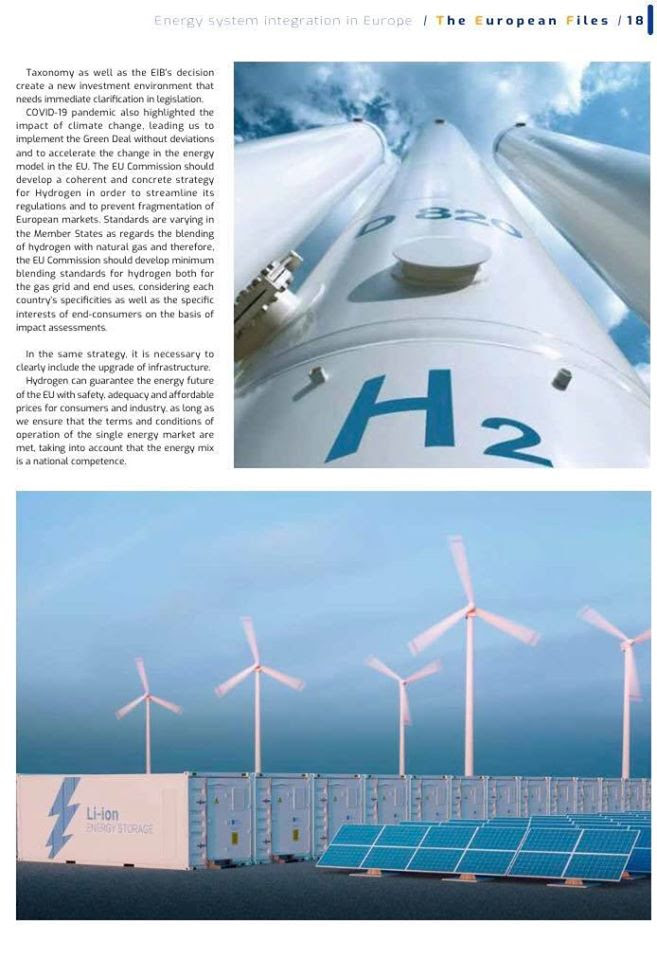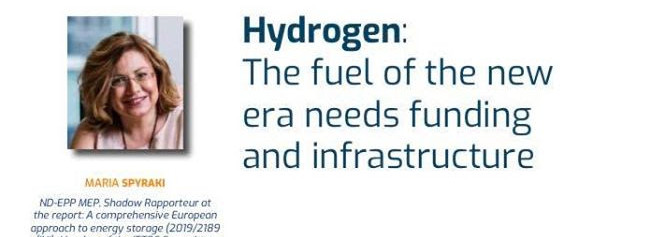Το υδρογόνο έχει τη δυνατότητα να γίνει ένας από τους σημαντικότερους ενεργειακούς φορείς του 21ου αιώνα και γι’ αυτό οφείλουμε έγκαιρα να εντάξουμε την παραγωγή - μεταφορά - διανομή του στον ενεργειακό σχεδιασμό της ΕΕ και των κρατών μελών, ξεκινώντας από την ενίσχυση της έρευνας ώστε να έχουμε προσβάσιμη τεχνολογία σε καλές τιμές. H Κομισιόν στην πρότασή της θα πρέπει να λάβει υπόψη της τις πραγματικές δυνατότητες παραγωγής υδρογόνου στην ΕΕ, αξιοποιώντας την υπάρχουσα υποδομή σε αγωγούς φυσικού αερίου, υπόγειες αποθήκες και τερματικούς σταθμούς υγροποιημένου φυσικού αερίου (LNG) καθώς και σε συσκευές τελικής χρήσης.
Hydrogen: The fuel of the new era needs funding and infrastructure
* by Maria Spyraki
Hydrogen has the potential to become one of the major energy carriers of the 21st century and therefore, we need to incorporate its production-transport-distribution into the energy planning of the EU and the Member States in a timely manner, starting with the enhancing of research in order to provide accessible technologies in affordable prices.
The European Union is already supporting Research and Development programs and support further scaling up of P2G (Power to Gas) as well as separation technologies. The new Horizon Europe has many opportunities for advanced and applied research in this field. However, it is important to upgrade hydrogen support at European level. One of the ways to achieve that is through the launching of a hydrogen initiative as an Important Project of Common European Interest (IPCEI), which will increase the availability of EU funds and the interest of the private sector to participate. Moreover, the potential additional cost of blending hydrogen into the natural gas grid must be considered in order to facilitate the end-users consumers and industry.
The coordinated steps of the EU including this sector can proceed on the basis of a strategy that will proposed by the Commission taking into account its actual potential production of hydrogen in the EU, the existing gas infrastructure is gas pipelines, underground storage and liquefied natural gas (LNG) terminals, as well as in end-use appliances. The same strategy will present the costs and benefits of retrofitting, where necessary, gas infrastructure and end-use appliances for the use of hydrogen either in pure or blended, gaseous or liquid forms.
It is essential to upgrade the existing infrastructure for the transmission of larger quantities of renewable gas and hydrogen. In addition, the construction of new infrastructure needed for the transportation of pure hydrogen is obviously too expensive. In order to move from the injection of hydrogen to pure hydrogen, EU needs strong and credible financial instruments.
In the political field it is necessary to recognise without rejoicing that European gas infrastructure has an important role to play in the energy transition towards a climate-neutral economy in 2050. The significant existing storage potential of European gas infrastructure can contribute inter alia to seasonal storage and mass-balancing of the energy system, ensuring security of supply, system integrity and providing adequate flexibility as more variable renewable electricity enters the energy system.
We must also agree that ensuring the futureproofing of EU gas infrastructure and utilising its storage potential can significantly reduce the cost of the energy transition. The existing gas infrastructure has an important role to play in integrating renewable gases such as locally produced bio-methane and hydrogen into the energy system.
In the meantime, we should also deal in advance with the issues related to the transportation and distribution of pure hydrogen. The existing natural gas infrastructure can be integrated into new hydrogen networks by transforming today's natural gas network operators into "combined network operators" as these can operate both mixed gas and pure hydrogen networks. The current rules for network operation only refer to natural gas networks, which may not yet be a problem for mixed gas networks. Hydrogen is fed into the natural gas network with a percentage varying per Member State, which does not go beyond the 15% safe limit. However, pure hydrogen networks are a major challenge for the energy transition. The development of pure hydrogen networks is limited because the current regulation framework neither allows such a network expansion nor it’s financing with network fees.
In parallel, the upgrade of existing infrastructure needs huge investments. In this regard it important to have clear rules in order to stabilize and facilitate the market starting with the legislative framework.
The Taxonomy Regulation will establish an EU-wide classification system intended to provide firms and investors with a common framework for identifying to what degree economic activities can be considered to be "environmentally sustainable".
However, the Taxonomy Regulation leaves many short-term and mid-term gaps concerning the role for natural gas as a transition fuel and the infrastructure needed. Therefore, further clarification shall be provided to this topic because it is obvious that it is fully related with the future of transmission of renewable gas and hydrogen.
Moreover, a few months ago the EIB announced its new lending policy phasing out support to energy projects reliant on unabated fossil fuels. This implies that the Bank will phase out support by 2021 to (i) the production of oil and natural gas; (ii) traditional gas infrastructure (networks, storage, refining facilities); (iii) power generation technologies resulting in GHG emissions above 250 gCO2 per kWh of electricity generated, averaged over the lifetime for gas-fired power plants seeking to integrate low carbon fuels and (iv) large-scale heat production infrastructure based on unabated oil, natural gas, coal or peat.
Taxonomy as well as the EIB's decision create a new investment environment that needs immediate clarification in legislation.
COVID-19 pandemic also highlighted the impact of climate change, leading us to implement the Green Deal without deviations and to accelerate the change in the energy model in the EU. The EU Commission should develop a coherent and concrete strategy for Hydrogen in order to streamline its regulations and to prevent fragmentation of European markets. Standards are varying in the Member States as regards the blending of hydrogen with natural gas and therefore, the EU Commission should develop minimum blending standards for hydrogen both for the gas grid and end uses, considering each country’s specificities as well as the specific interests of end-consumers on the basis of impact assessments.
In the same strategy, it is necessary to clearly include the upgrade of infrastructure.
Hydrogen can guarantee the energy future of the EU with safety, adequacy and affordable prices for consumers and industry, as long as we ensure that the terms and conditions of operation of the single energy market are met, taking into account that the energy mix is a national competence.
* Maria Spyraki is a ND-EPP MEP, Shadow Rapporteur at the report: A comprehensive European approach to energy storage (2019/2189 (INI))


